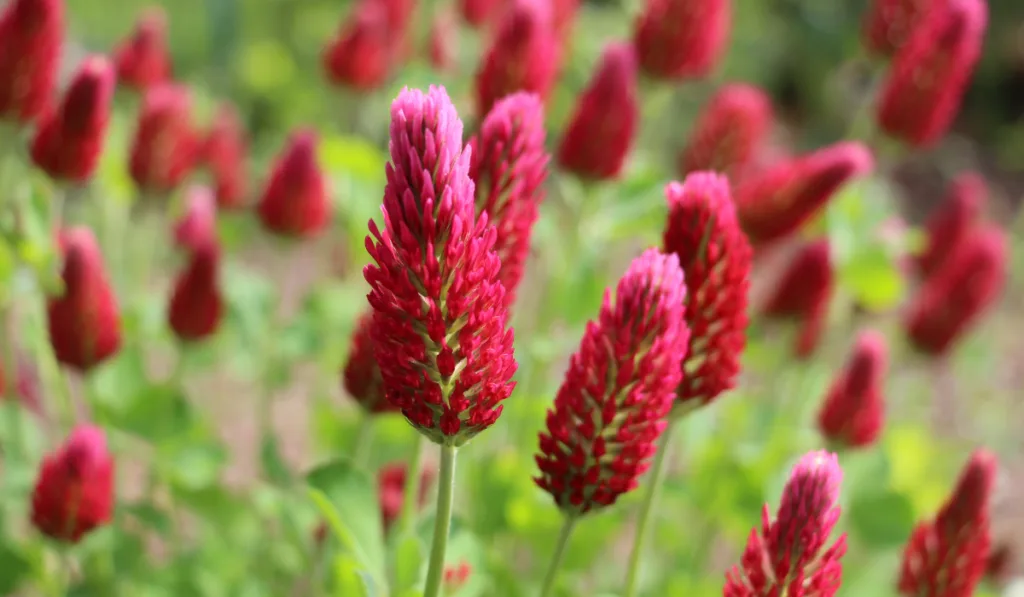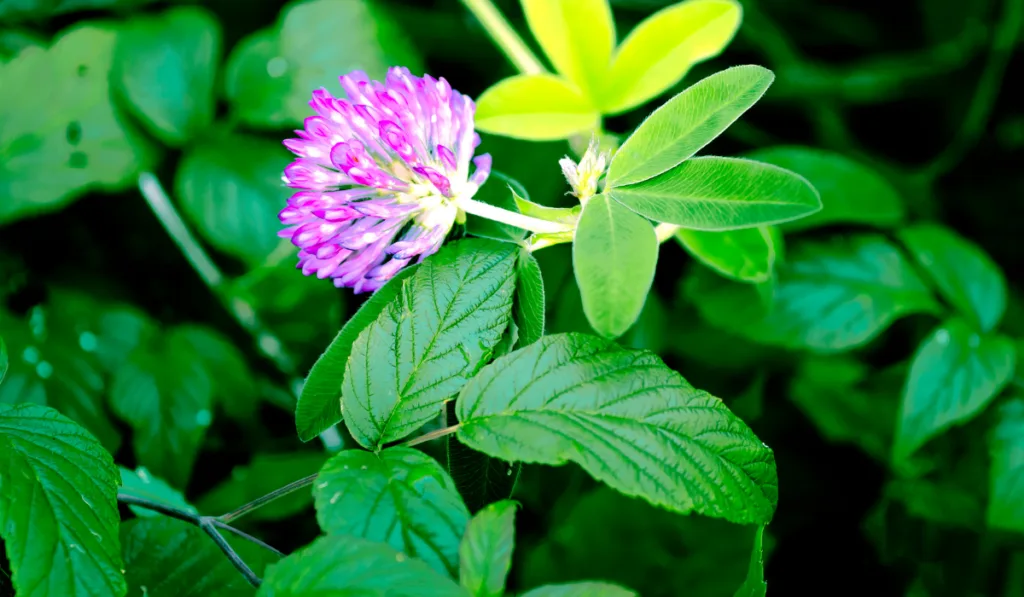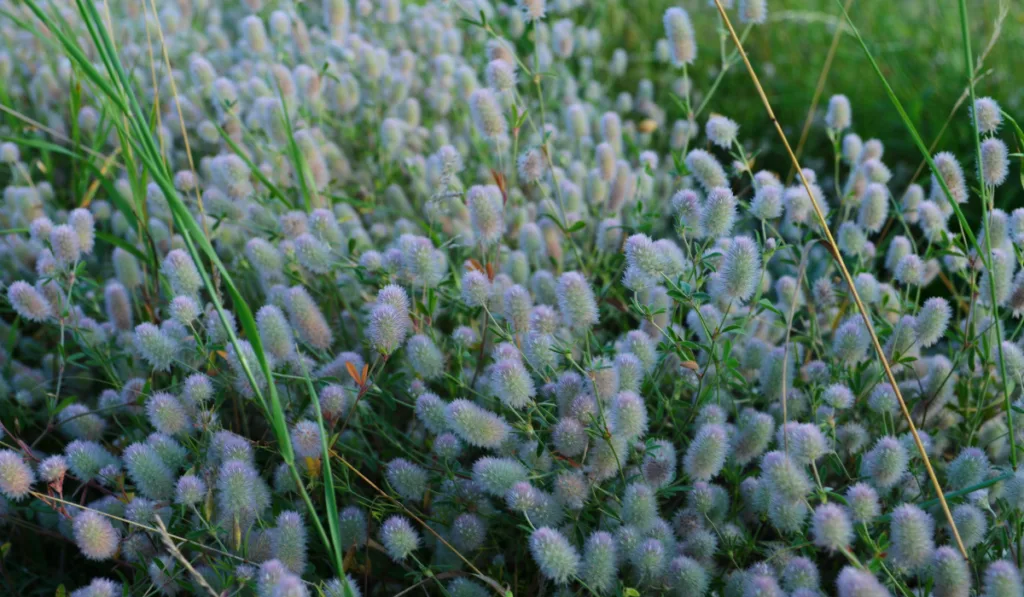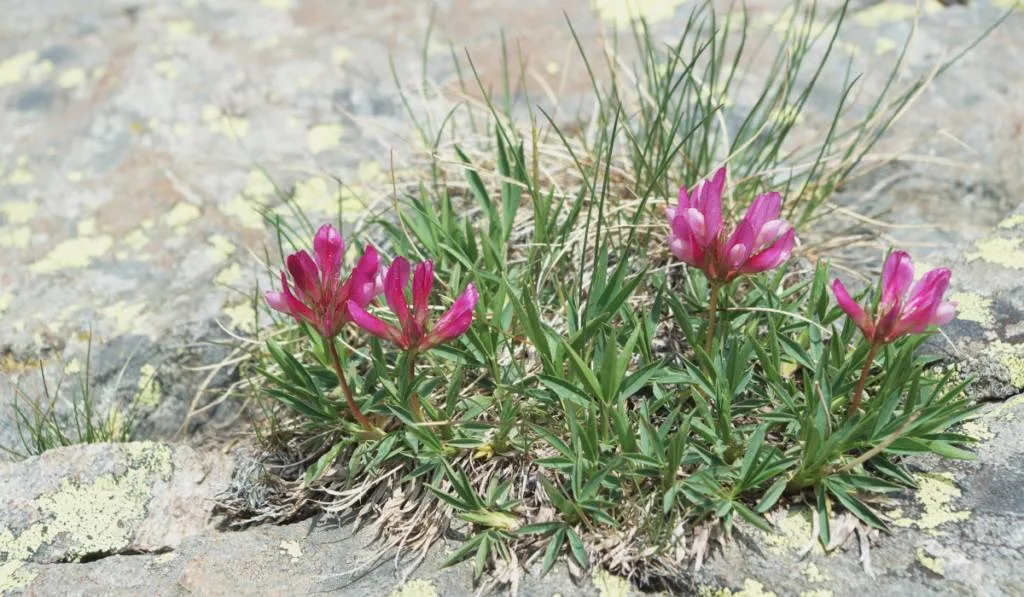Clovers are very beautiful and useful plants. While you’d love to see them in your yard because of their look, they also help to enrich the soil for other plants.
Just like every other type of plant, there are different varieties of clovers. Would you love to know some of the most popular ones? Read this article to discover thirteen types of clovers.
Table of Contents
1. White Clover (Trifolium repens)

- USDA hardiness zone: 4-8
- Size: 4-6 inches tall and 12-inch spread.
- Flower color: White
This beautiful clover will give you incredibly beautiful white flowers when in bloom. Before its bloom, however, you’d hardly identify the plant.
White clovers are often used in lawns, as they spread to form mats quickly. They form a dense mat, so you’d have a healthy lawn for a long time.
Growing these plants is easy. Give them four or more hours of direct sunlight daily. Also, ensure that the soil is slightly acidic.
You can easily get white or ‘three-leaved’ clover seeds from gardening stores near you, as this is a popular variety.
2. Alsike Clover (Trifolium hybridum)

- USDA hardiness zone: 3-8
- Size: 1-2 feet tall.
- Flower color: Light pink to white.
Are you looking for multi-purpose plants? Here’s an awesome clover variety to consider.
The beautiful Alsike clover serves as a good source of feed for livestock such as cows and sheep.
Remember that clovers are rich in nitrogen and help enrich the soil.
While your livestock will eat other nutritious products that you supply, you can grow this variety of clover in your yard as a source of extra nutrients for the animals.
Note that this variety is mildly toxic for people, so don’t try to eat the leaves. It is completely safe for animals, especially ruminant ones.
3. Red Clover (Trifolium pratense)

- USDA hardiness zone: 5-9
- Size: 12-18 inches tall.
- Flower color: White or pink to red.
This is a popular clover variety, and you’d surely appreciate its uses when you come to know it. Aside from enriching the soil and acting as a source of nutrients for animals, red clovers can also be used to cure some ailments.
Red clovers were often used in traditional medicine in curing certain illnesses, hence their popularity.
These clovers make good lawn clovers, as they will fill your lawns with mostly pink flowers.
Red clovers are completely safe for people, so you don’t have to fear any form of toxicity in your lawn.
To grow these beautiful clovers, ensure that the soil is well-drained. Also, the soil pH should not go above 7 (neutral).
4. Strawberry Clover (Trifolium fragiferum)

- USDA hardiness zone: 3-9
- Size: 4-12 inches tall
- Flower color: Pink to white
This beautiful clover originates from Europe, Asia, some parts of Africa, and other parts of the world. It is popular for its uses and looks.
Before they open up, the flowers of strawberry clovers look so much like strawberries because of their colors.
While you can grow these plants as forage plants for your animals, you can also use them to prevent erosion in your lawn. They spread and twist their roots with the roots of others quickly.
You can grow this plant in nutrient-depleted soil. However, provide them with extra nutrients, especially phosphorus and potassium.
5. Dwarf Clover (Trifolium nanum)
- USDA hardiness zone: 2-11
- Size: 2 inches tall.
- Flower color: Pink
This low-growing clover originates from mountain tops. It is now a common plant for fixing nitrogen as well as feeding animals. One extra use of this clover is as a cover crop.
As a plant that grows comfortably in cold places, you can plant dwarf clovers in winter to hold your soil nutrients and structure.
Like other cover crops, you’d turn this plant back into the soil when you are ready so that it can decompose and release its nutrients.
6. Egyptian Clover (Trifolium alexandrinum)

- USDA hardiness zone: 3-9
- Size: 1.3-3 feet tall.
- Flower color: White to yellow.
Here’s one variety that you’d love. This beautiful clover has long been cultivated in Egypt, where it was used as a leguminous forage.
The clover grows to form a dense mat, and, in some months, your yard will be filled with green vegetation with beautiful white flowers.
The entirety of the Egyptian clover is edible, though people prefer eating the seeds while giving the other parts of the plant to their livestock.
While this is a hardy plant, it still needs your care. Ensure that it gets at least four hours of direct sun daily. Also, keep the soil moist but not soggy.
7. Suckling Clover (Trifolium dubium)

- USDA hardiness zone: 5-10
- Size: Close to 2 feet tall.
- Flower color: Yellow
The suckling clover has a national importance in Ireland where it serves as the traditional Irish shamrock.
Like other clover varieties, the suckling clover fixes nitrogen into the soil with the help of nitrogen-fixing bacteria. This means that you can have a nutrient-rich yard when you grow clovers.
To grow this beauty clover, ensure that you are living in the right zone (zones 5-10), as you may face a few challenges if you grow the plants in unsuitable zones.
8. Subterranean Clover (Trifolium subterraneum)

- USDA hardiness zone: Zones 7 and above.
- Size: 7-9 inches.
- Flower color: White to purple.
Are you looking for a clover variety to grow but can’t decide which to start with? The subterranean clover is a good idea for you.
This is a very hardy clover variety, and you simply can’t go wrong when growing it so long as you plant it in its preferred USDA hardiness zone.
A lot of people view this variety as a weed because of its hardy nature. However, it will serve its purpose well if you use it to fill empty lawn patches.
To grow subterranean clovers, you need partial shade to full sun. Note that the plants grow optimally in full sun.
9. Cows Clover (Trifolium wormskioldii)
- USDA hardiness zone: Zones 7 and above.
- Size: Over 3 feet tall.
- Flower color: Pink to purple.
As the name suggests, the cows clover has a thing or two to do with cows. This is a highly recommended clover variety for livestock owners.
When you grow this clover in your fields, your cows and other farm animals will get a steady supply of plant nitrogen. This clover variety grows quickly and supplies nitrogen to animals.
Cows clover will also enrich the soil, so growing other plants for your grazing animals around your clover will help you save a lot of money used for nutrients.
If you’d love to grow this clover, ensure to properly spread the seeds so that the plants do not grow too compacted.
Also, regularly put their height in check, especially if the cows do not eat as quickly as the plants grow.
10. Zigzag Clover (Trifolium medium)

- USDA hardiness zone: 5-9
- Size: 8-18 inches tall.
- Flower color: Red to purple petals.
Here’s one hardy clover variety to consider growing.
The zigzag clover grows well on heavy soil, so you can plant it in your yard even if the soil is unsuitable for other plants.
So long as you are in the right zone, you can sow zigzag clovers throughout the year.
These clovers spread quickly and might outgrow other plants, so ensure that you don’t sow too many of their seeds if you intend to mix them with other clovers.
With occasional watering, your clovers will grow just fine.
11. Hare’s-Foot Clover (Trifolium arvense)

- USDA hardiness zone: 5-9
- Size: 4-16 inches tall.
- Flower color: White to pale pink.
Here is a toxic clover that you don’t want anywhere near your yard.
The hare’s-Foot clover variety is toxic to both people and animals, so it’s best you avoid it or just appreciate its beauty from a distance.
The white to pale pink flowers of this variety have a fuzzy look, giving the plant its name, as the feet of hares are fuzzy as well.
This clover grows naturally in Europe and Asia. However, it has been naturalized in other parts of the world.
Though it is toxic, it helps to fix nitrogen in the soil like other varieties.
12. Alpine Clover (Trifolium alpinum)

- USDA hardiness zone: Zones 5 and above.
- Size: 6-8 inches.
- Flower color: White to light red.
As the name suggests, you can only find these clovers naturally in the Alps. This beautiful plant is a sight to behold, as it grows on unlikely objects such as rocks.
The alpine clover is a trifoliate plant that has slim leaves. If you look at it from a distance, it looks so much like grass.
However, you get to appreciate its beauty when you get closer.
The bright pink, red, or white flowers grow on tall stalks. When the plant grows on rocks, these flowers will most likely be the brightest objects in your view. This variety is truly a beautiful one.
The variety is perennial, so it lives for a long time (three years or more).
13. Mountain Clover (Trifolium montanum)

- USDA hardiness zone: Zones 5 and above.
- Size: 8-20 inches tall.
- Flower color: White to light yellow.
Here is another plant with national importance. This beautiful clover is the official flower of Oslo, Norway.
The beautiful flowers of mountain clover have a green center each, making the flowers fit the leaves in an ornamental fashion. This gives the clover a very beautiful view.
This variety is non-toxic and completely safe to grow in yards. Just ensure that you grow it in the right zones so that you don’t face some challenges when growing it.
Final Thoughts
Clovers are truly remarkable, right? These beauties are also super hardy and will grow problem-free in your yard so long as you grow them in the right region and take good care of them.
Remember to keep your lawn, yard, or garden nutrient-rich for your clovers so that they can assist you in enriching the soil with extra nitrogen.
